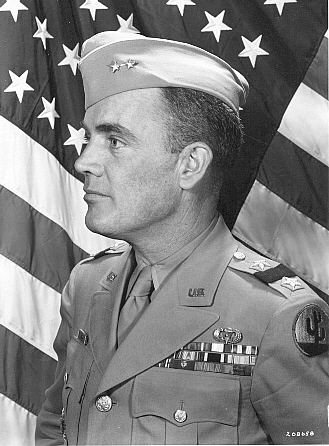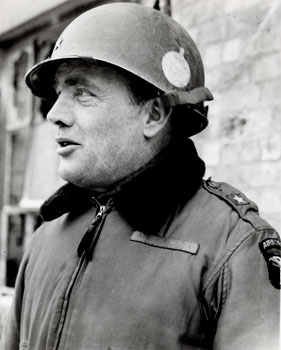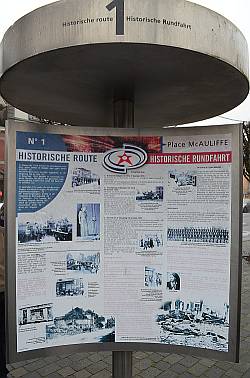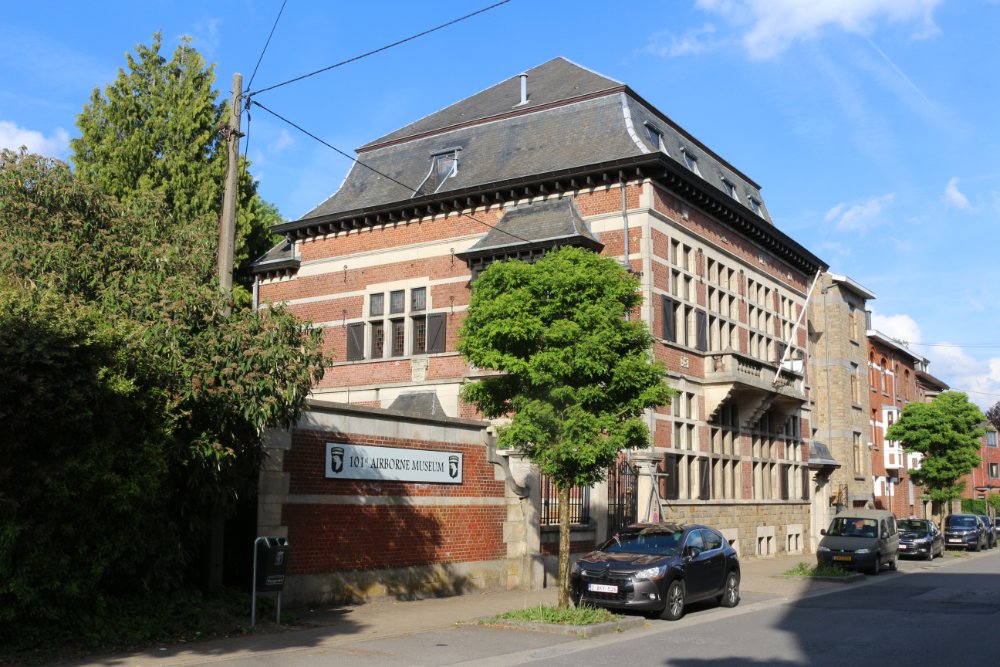McAuliffe, Anthony Clement
- Date of birth:
- July 2nd, 1898 (Washington DC, United States)
- Date of death:
- August 11th, 1975 (Chevy Chase/Maryland, United States)
- Buried on:
- Arlington National Cemetery
Plot: 3. Grave: 2536. - Service number:
- 012263
- Nationality:
- American
Biography
Anthony Clement McAuliffe was born in Washington, D.C., 2 July 1898. He was trained at the United States Military Academy and twice graduated on 1 November 1918 and in July 1919. The first time was in relation to duty in Europe during the First World War, but the end of the war kept him on the Academy.
In September 1919, he was detailed to the Field Artillery School at Camp Zachary Taylor, Kentucky and graduated in August 1920. He was assigned to the 16th Field Artillery at Camp Lewis, Washington. In August 1922, he became Plans and Training officer for a battalion of the 76th Field Artillery at the Presidio of Monterey, California. In October 1923, he was assigned to the 11th Field Artillery at Schofield Barracks, Hawaii, serving until October 1926. After that he went to Fort Riley, Kansas, with the 9th Field Artillery. In November 1927, he joined the 6th Field Artillery at Fort Hoyle, Maryland, and in November 1929 he was assigned to the 1st Field Artillery Brigade. In March 1932 he was attached to Brigadier General James G. Gowen as his aide in Schofield Barracks, Hawaii. He became assistant to the Plans and Training officer of the Hawaiian Department in January 1935, also continuing his duties as aide to General Gowen. In July 1935, he was assigned to the 11th Field Artillery at Schofield Barracks.
In August 1936, he entered the Command and General Staff School at Fort Leavenworth, Kansas. He graduated in June 1937, and was assigned to the 1st Field Artillery at Fort Sill, Oklahoma, where in June 1938, he became an instructor at the Field Artillery School. He entered the Army War College in September 1939, and was graduated in June 1940. He then became assistant chief of the Development Section of the Requirements and Distribution Branch, Supply Division, War Department General Staff. He was designated chief of the Ordnance and Coast Artillery Section, Development Branch, Supply Division in January 1942, and the following March was assigned to the Requirements Division at Headquarters, Army Service Forces (then Services of Supply).
In August 1942, he joined the 101st Airborne Division at Camp Claiborne, Louisiana, as artillery commander and subsequently sailed with it to Europe. During the invasion of Normandy, he parachuted into France the night of 5 - 6 June 1944. He commanded a task force which captured the town of Carentan. With the airborne invasion of Holland, General McAuliffe, commanded the Glider Echelon and entered Holland by glider on 18 September 1944. He commanded a task force of the division in the defense of the bridge and town of Veghel. In December 1944, in the absence of the division commander, he was the acting commander of the 101st Airborne Division and attached troops in the defense of the key road center of Bastogne, Belgium during the Battle of the Bulge. When surrounded by the German Army and given an ultimatum to surrender, he responded with a single word answer, "NUTS". That reply made him famous. He assumed command of the 103rd Infantry Division in January 1945. In March 1945, the 103rd Division broke through the Siegfried Line, and raced through Germany and Austria to capture Innsbruck and the Brenner Pass and make the historic link-up with the American Fifth Army troops from Italy. In July 1945, he assumed command of the 79th Infantry Division. WWII ended in August 1945 and he returned to the United States.
In September 1945, he was assigned to command the Airborne Center at Camp Mackall, North Carolina. In December 1945, he assumed command of Fort Bragg, North Carolina. A month later he became the U. S. Army Ground Forces advisor to Vice Admiral Blandy, commander of joint Army Navy Task Force One, for Operation Crossroads, the tests of the atomic bomb. He served at Bikini throughout the tests and returned in August 1946. He became Army Secretary of the Joint Research and Development Board at Army Headquarters at the Pentagon in Washington, DC. In December 1947, he was designated deputy director for Research and Development of the Logistics Division Army General Staff. He was sent to Japan in March 1949, and a month later assumed command of the 24th Infantry Division there. In September 1949, he was appointed Chief of the Chemical Corps at Washington, D.C. On May 23, 1951, he was assigned as Assistant Chief of Staff for Personnel at Army Headquarters. He became Deputy Chief of Staff for Operations and Administration at Army Headquarters in February 1953. In October 1953, he assumed command of the U.S. Seventh Army in Germany. In December 1954, he was named Commanding General, United States Army in Europe.
General McAuliffe retired from the U.S. Army on 31 May 1956. He died at Walter Reed Army Medical Center on August 11,1975.
He is buried in Section 3 of the Arlington National Cemetery, Arlington, VA.
Promotions:
?: First Lieutenant;
1935: Captain;
?: Major;
December 1941: Lieutenant Colonel;
1942: Colonel;
1944: Brigadier General;
?: Major General;
?: Lieutenant General;
?: General.
Career:
1916 - 1917: West Virginia University;
June 1917 - November 1918: War Emergency Course, U.S. Military Academy;
June 1919: West Point;
?: Army Field Artillery School in Camp Zachary, Kentucky;
1920 - 1922: Fort Lewis, Washington;
1923: Schofield Barracks, Oahu, Hawaii;
?: Fort Riley, Kansas;
1927 - 1932: Fort Hoyle, Maryland;
1932 - 1936: Hawaii;
1936: United States Army Command and General Staff College, Fort Leavenworth;
1936 - 1939: instructor Artillery School Fort Still, Oklahoma;
1940 - June 1940: Army War College, Carlisle Barracks, Pennsylvania;
? - 1942: G-4 Division, War Department General Staff;
1942: Army Service Forces;
1942 - 1944: Commander Division Artillery, 101st Airborne Division;
1944 - 1945: Assistant Commanding General 101st Airborne Division;
1944 - 1945: Acting Commanding General 101st Airborne Division;
January 15th, 1945 - July 1945: Commanding Officer 103rd Infantry Division, US 7th Army;
1945: Commanding General 79th Division;
1945 - 1946: Commanding General Airborne Center;
1946: Army Ground Force Advisor, Operation Crossroads;
1946 - 1947: Army Secretary, Joint Research & Development Board;
1946 - 1949: Deputy Director of Research & Development, Logistics Division, General Staff US Army;
1949: Commanding General 24th Division;
1949 - 1953: Chief of the Chemical Corps, Department of the Army;
1951 - 1953: Assistant Chief of Staff (G1-Personnel) US Army;
1953: Deputy Chief of Staff for Operations & Administration US Army;
September 29th, 1953 - February 1st, 1955: Commanding General 7th United States Army;
February 1st, 1955 - May 1st, 1956: Commanding General U.S. Army Europe;
1956: Retirement;
1956 - 1963: Vice President for Personnel American Cyanamid Corporation;
1960 - 1963: Chairman New York State Civil Defense.
Do you have more information about this person? Inform us!
- Period:
- Second World War (1939-1945)
- Rank:
- Brigadier General
- Awarded on:
- June 20th, 1944
"For gallantry in action. On 6 June 1944, Brigadier General McAuliffe, without having received formal instruction in parachuting, volunteered to drop with the parachute echelon of the Headquarters Battery of the Division Artillery of the 101st Airborne Division in order to organize his artillery expeditiously. Landing far from the prescribed drop zone, he organized the scattered individuals of his Headquarters and joined with elements of Division Headquarters south of St. Marie du Mont. In conjunction with the latter, he led his artillery against the causeway at Pouppeville and assisted in capturing the town and beach defile against strong enemy resistance. The speedy juncture of airborne and sea borne forces at this point was in large measure due to his leadership. His conduct was in accordance with the highest standards of military service."
Presented by General Troy Middleton, Commander, VIII Corps, at Carentan, France.
- Period:
- Second World War (1939-1945)
- Rank:
- Brigadier General
- Unit:
- Commanding General, 101st Airborne Division "Screaming Eagles", U.S. Army
- Awarded on:
- December 30th, 1944
"For extraordinary heroism in connection with military operations against an armed enemy. During the period 17 December to 26 December 1944, General McAuliffe was in command of the 101st Airborne Division during the siege of Bastogne, Belgium, by overwhelming enemy forces. Though the city was completely surrounded by the enemy, the spirit of the defending troops under this officer's inspiring, gallant leadership never wavered. Their courageous stand is epic. General McAuliffe continuously exposed himself to enemy bombing, strafing and armored and infantry attacks to personally direct his troops, utterly disregarding his own safety. His courage, fearless determination and inspiring, heroic leadership exemplify the highest tradition of the military forces of the United States."
Presented by General George Patton, Commander, 3rd Army, at Bastogne, Belgium.
- Period:
- Second World War (1939-1945)
- Awarded on:
- April 2nd, 1945
- Period:
- Second World War (1939-1945)
- Awarded on:
- April 2nd, 1945
Received as a clasp for on the ribbon of the first DSO.
- Period:
- Second World War (1939-1945)
- Rank:
- Major General
- Unit:
- HQ, 103rd Infantry Division, U.S. Army
- Awarded on:
- March 26th, 1945
“For meritorious service in action from 15 March to 24 March in France and Germany. His division spearheaded the VI Corps offensive which broke the shoulder of the enemy's Saar Palatinate salient, inflicting heavy casualties on personnel and equipment. To achieve these results, General McAuliffe displayed outstanding aggressiveness and unhesitating initiative in leading his forces over difficult terrain and against elaborate fixed fortification including the extremely well fortified key position as Riesdorf. His exceptional field leadership was demonstrated in the brilliant maneuvers which isolated countless enemy formations and thwarted every attempt by them to escape.”
- Period:
- Second World War (1939-1945)
- Rank:
- Major General
- Unit:
- HQ, 103rd Infantry Division, U.S. Army
- Awarded on:
- May 6th, 1945
“Anthony C. McAuliffe, 012263, Major General, United States Army, 103rd Infantry Division, for meritorious service in action from 20 April to 5 May 1945 in Germany and Austria.”
Received as Oak Leaf Cluster on the ribbon of the first Bronze Star.
- Period:
- Second World War (1939-1945)
- Rank:
- Major General
- Unit:
- Commanding General, 101st Airborne Division "Screaming Eagles", U.S. Army
- Awarded on:
- May 11th, 1945
"General McAuliffe commanded the 101st Airborne Division during it epic defense of the city of Bastogne, Belgium, from 17 to 27 December 1944.
On 17 December he moved his command from a rest area to Bastogne with the mission of holding that important communications center against an all out German winter offensive in the Ardennes. He immediately established a perimeter defense of the city, prepared to withstand the imminent attack. General McAuliffe's accurate estimate of the situation and his tactical dispositions were such as to present to the numerically superior German forces completely encircling him an impenetrable defense.
The enemy, realizing the importance of the road new stemming from Bastogne, launched repeated, furious and relentless attacks on the surrounded garrison for a period of ten days. During this time General McAuliffe's unit was completely cut off from friendly troops. His personal and individual defiance of the enemy, however, was such as to inspire all members of his command to carry out his instructions willingly and eagerly. Under General McAuliffe's dynamic leadership the 101st Airborne Division and attached troops denied to the enemy one of the prime objectives of his Ardennes offensive."
Presented by General Jacob Devers, Commander, 6th Army Group, at Innsbruck, Austria on May 11, 1945.
- Period:
- Second World War (1939-1945)
- Rank:
- Major General
- Unit:
- HQ, 103rd Infantry Division, U.S. Army
- Awarded on:
- 1945
"Major General Anthony C. McAuliffe, United States Army, for exceptionally meritorious conduct in the performance of outstanding
services as Commanding General, 103rd Infantry Division from 21 April 1945 to 6 May 1945. Major General McAuliffe commanded the 103rd Infantry Division in its rapid southward drive through Germany and Austria to make a junction with American Fifth Army elements at Vipiteno, Italy, forcing the unconditional surrender of the 19th German Army.
Major General McAuliffe's extraordinary skill, constant aggressiveness and devotion to duty contributed materially to bringing the war in Europe to a speedy and successful conclusion, reflecting the highest credit upon him and the armed forces of the United States.”
- Period:
- Second World War (1939-1945)
- Rank:
- Brigadier General
- Unit:
- Commanding General, 101st Airborne Division "Screaming Eagles", U.S. Army
- Awarded on:
- November 14th, 1946
Royal decree no. 35
- Period:
- Second World War (1939-1945)
- Period:
- Second World War (1939-1945)
- Period:
- Second World War (1939-1945)
- Period:
- Second World War (1939-1945)
- Period:
- Second World War (1939-1945)
Sources
- Photo 1: US Army photo
- - Pallud, Jean Paul, Battle of the Bulge – Then and Now, After the Battle 1984, Battle of Britain International Limited, London, England, 1984
- Family Records
- Kenneth McAuliffe Jr.
- U.S. Army Center for Military History
- Arlingtoncemetery.net
- Eastmill.com



















